Unit 6: Equality and Diversity in the Health Sector Assignment
VerifiedAdded on 2023/01/05
|20
|6811
|51
Homework Assignment
AI Summary
This assignment, designed for a Level 2 Certificate in Understanding Working in the Health Sector, Unit 6, focuses on equality and diversity within the healthcare environment. The assignment is divided into two parts. Part 1 defines key terms such as diversity, equality, inclusion, and discrimination, and explores the benefits of a diverse workforce and the impact of policies on healthcare service users. Part 2 examines legislation and codes of practice that support equality and diversity, identifies practices to reduce discrimination in the workplace, and addresses the rights of individuals with protected characteristics. The assignment includes examples of policies and legislation, and requires the student to demonstrate an understanding of how these elements contribute to a fair and inclusive healthcare setting. The student provides detailed answers to the questions and illustrates their understanding with relevant examples.
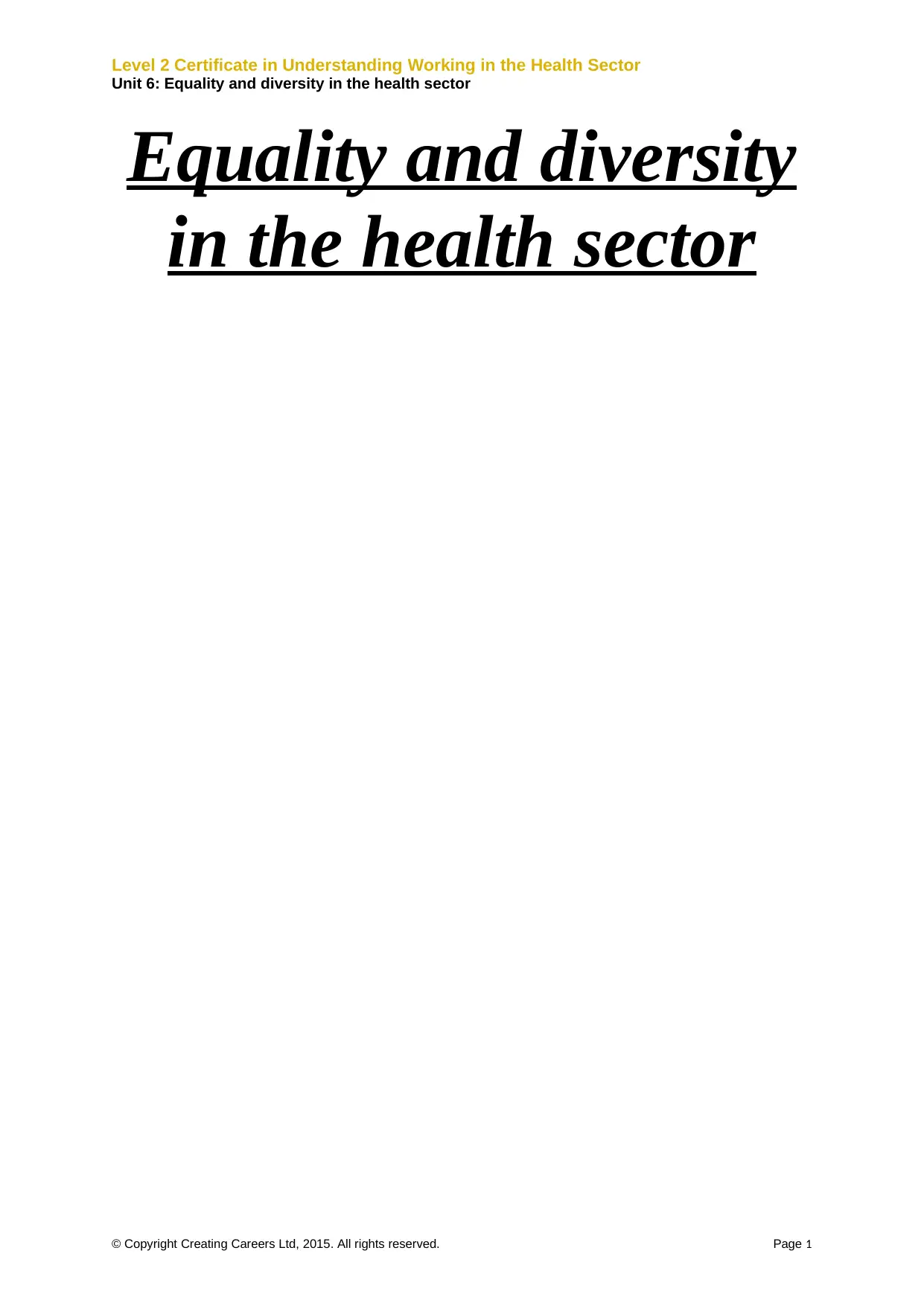
Level 2 Certificate in Understanding Working in the Health Sector
Unit 6: Equality and diversity in the health sector
Equality and diversity
in the health sector
© Copyright Creating Careers Ltd, 2015. All rights reserved. Page 1
Unit 6: Equality and diversity in the health sector
Equality and diversity
in the health sector
© Copyright Creating Careers Ltd, 2015. All rights reserved. Page 1
Paraphrase This Document
Need a fresh take? Get an instant paraphrase of this document with our AI Paraphraser
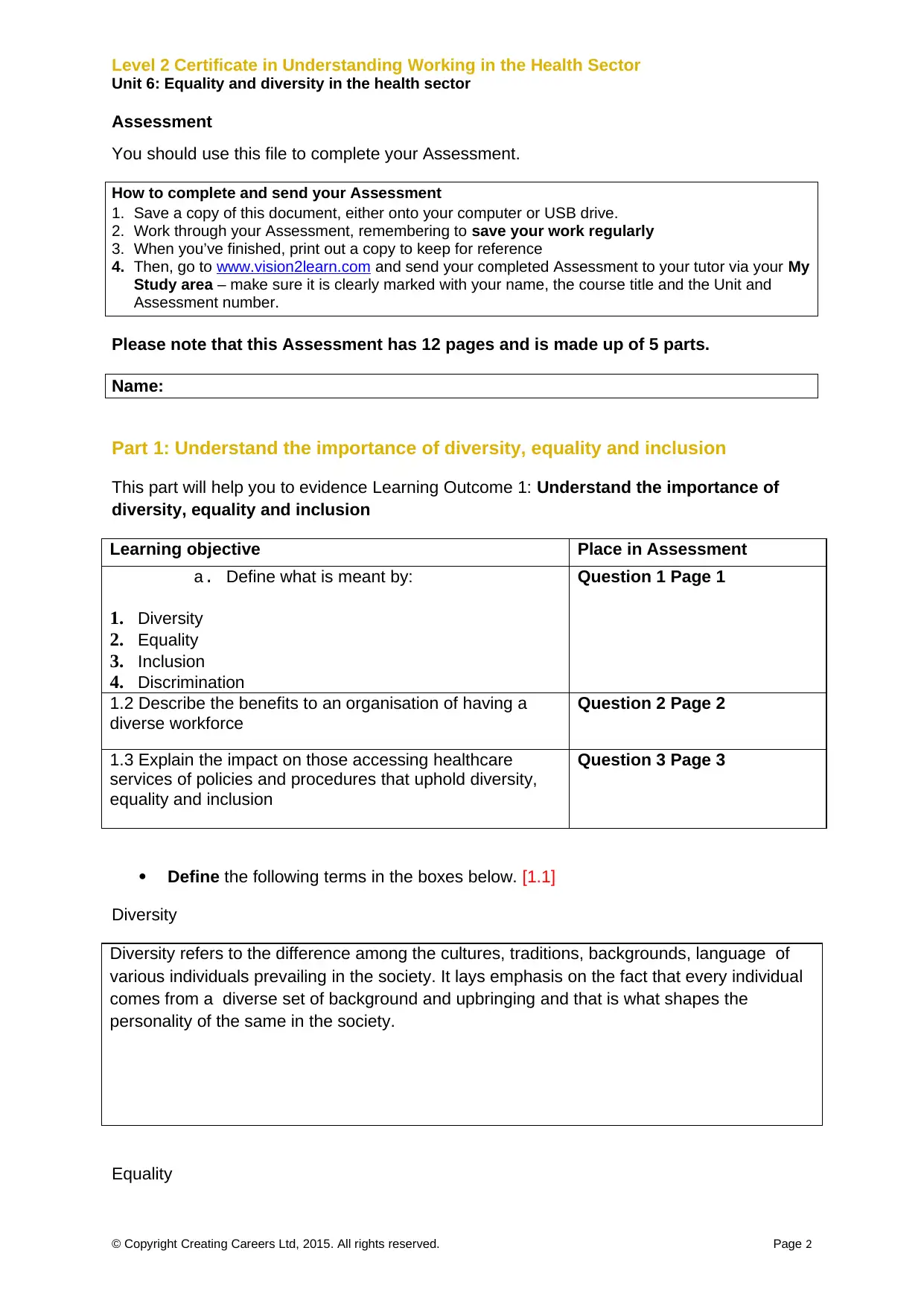
Level 2 Certificate in Understanding Working in the Health Sector
Unit 6: Equality and diversity in the health sector
Assessment
You should use this file to complete your Assessment.
How to complete and send your Assessment
1. Save a copy of this document, either onto your computer or USB drive.
2. Work through your Assessment, remembering to save your work regularly
3. When you’ve finished, print out a copy to keep for reference
4. Then, go to www.vision2learn.com and send your completed Assessment to your tutor via your My
Study area – make sure it is clearly marked with your name, the course title and the Unit and
Assessment number.
Please note that this Assessment has 12 pages and is made up of 5 parts.
Name:
Part 1: Understand the importance of diversity, equality and inclusion
This part will help you to evidence Learning Outcome 1: Understand the importance of
diversity, equality and inclusion
Learning objective Place in Assessment
a. Define what is meant by:
1. Diversity
2. Equality
3. Inclusion
4. Discrimination
Question 1 Page 1
1.2 Describe the benefits to an organisation of having a
diverse workforce
Question 2 Page 2
1.3 Explain the impact on those accessing healthcare
services of policies and procedures that uphold diversity,
equality and inclusion
Question 3 Page 3
Define the following terms in the boxes below. [1.1]
Diversity
Diversity refers to the difference among the cultures, traditions, backgrounds, language of
various individuals prevailing in the society. It lays emphasis on the fact that every individual
comes from a diverse set of background and upbringing and that is what shapes the
personality of the same in the society.
Equality
© Copyright Creating Careers Ltd, 2015. All rights reserved. Page 2
Unit 6: Equality and diversity in the health sector
Assessment
You should use this file to complete your Assessment.
How to complete and send your Assessment
1. Save a copy of this document, either onto your computer or USB drive.
2. Work through your Assessment, remembering to save your work regularly
3. When you’ve finished, print out a copy to keep for reference
4. Then, go to www.vision2learn.com and send your completed Assessment to your tutor via your My
Study area – make sure it is clearly marked with your name, the course title and the Unit and
Assessment number.
Please note that this Assessment has 12 pages and is made up of 5 parts.
Name:
Part 1: Understand the importance of diversity, equality and inclusion
This part will help you to evidence Learning Outcome 1: Understand the importance of
diversity, equality and inclusion
Learning objective Place in Assessment
a. Define what is meant by:
1. Diversity
2. Equality
3. Inclusion
4. Discrimination
Question 1 Page 1
1.2 Describe the benefits to an organisation of having a
diverse workforce
Question 2 Page 2
1.3 Explain the impact on those accessing healthcare
services of policies and procedures that uphold diversity,
equality and inclusion
Question 3 Page 3
Define the following terms in the boxes below. [1.1]
Diversity
Diversity refers to the difference among the cultures, traditions, backgrounds, language of
various individuals prevailing in the society. It lays emphasis on the fact that every individual
comes from a diverse set of background and upbringing and that is what shapes the
personality of the same in the society.
Equality
© Copyright Creating Careers Ltd, 2015. All rights reserved. Page 2
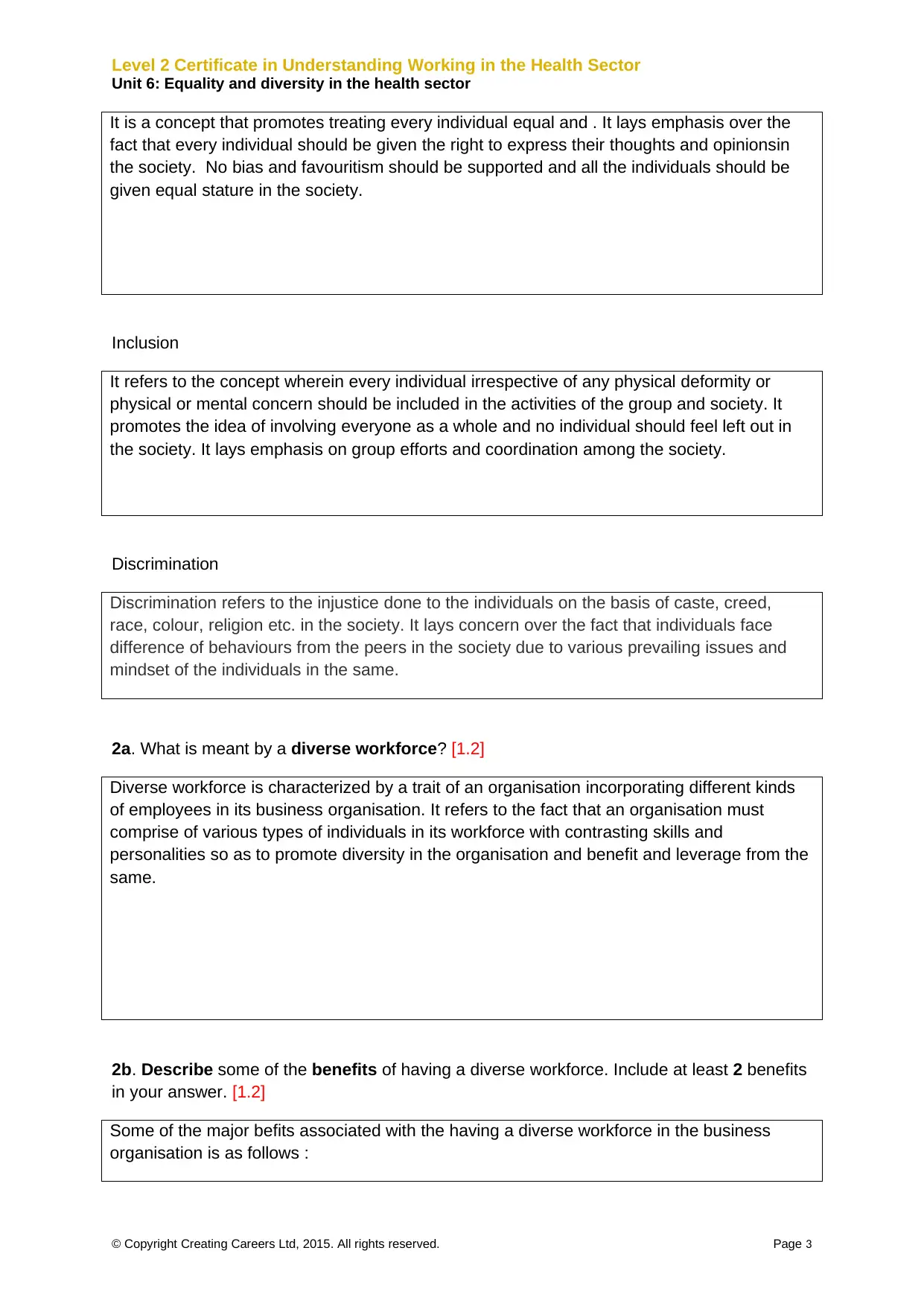
Level 2 Certificate in Understanding Working in the Health Sector
Unit 6: Equality and diversity in the health sector
It is a concept that promotes treating every individual equal and . It lays emphasis over the
fact that every individual should be given the right to express their thoughts and opinionsin
the society. No bias and favouritism should be supported and all the individuals should be
given equal stature in the society.
Inclusion
It refers to the concept wherein every individual irrespective of any physical deformity or
physical or mental concern should be included in the activities of the group and society. It
promotes the idea of involving everyone as a whole and no individual should feel left out in
the society. It lays emphasis on group efforts and coordination among the society.
Discrimination
Discrimination refers to the injustice done to the individuals on the basis of caste, creed,
race, colour, religion etc. in the society. It lays concern over the fact that individuals face
difference of behaviours from the peers in the society due to various prevailing issues and
mindset of the individuals in the same.
2a. What is meant by a diverse workforce? [1.2]
Diverse workforce is characterized by a trait of an organisation incorporating different kinds
of employees in its business organisation. It refers to the fact that an organisation must
comprise of various types of individuals in its workforce with contrasting skills and
personalities so as to promote diversity in the organisation and benefit and leverage from the
same.
2b. Describe some of the benefits of having a diverse workforce. Include at least 2 benefits
in your answer. [1.2]
Some of the major befits associated with the having a diverse workforce in the business
organisation is as follows :
© Copyright Creating Careers Ltd, 2015. All rights reserved. Page 3
Unit 6: Equality and diversity in the health sector
It is a concept that promotes treating every individual equal and . It lays emphasis over the
fact that every individual should be given the right to express their thoughts and opinionsin
the society. No bias and favouritism should be supported and all the individuals should be
given equal stature in the society.
Inclusion
It refers to the concept wherein every individual irrespective of any physical deformity or
physical or mental concern should be included in the activities of the group and society. It
promotes the idea of involving everyone as a whole and no individual should feel left out in
the society. It lays emphasis on group efforts and coordination among the society.
Discrimination
Discrimination refers to the injustice done to the individuals on the basis of caste, creed,
race, colour, religion etc. in the society. It lays concern over the fact that individuals face
difference of behaviours from the peers in the society due to various prevailing issues and
mindset of the individuals in the same.
2a. What is meant by a diverse workforce? [1.2]
Diverse workforce is characterized by a trait of an organisation incorporating different kinds
of employees in its business organisation. It refers to the fact that an organisation must
comprise of various types of individuals in its workforce with contrasting skills and
personalities so as to promote diversity in the organisation and benefit and leverage from the
same.
2b. Describe some of the benefits of having a diverse workforce. Include at least 2 benefits
in your answer. [1.2]
Some of the major befits associated with the having a diverse workforce in the business
organisation is as follows :
© Copyright Creating Careers Ltd, 2015. All rights reserved. Page 3
⊘ This is a preview!⊘
Do you want full access?
Subscribe today to unlock all pages.

Trusted by 1+ million students worldwide
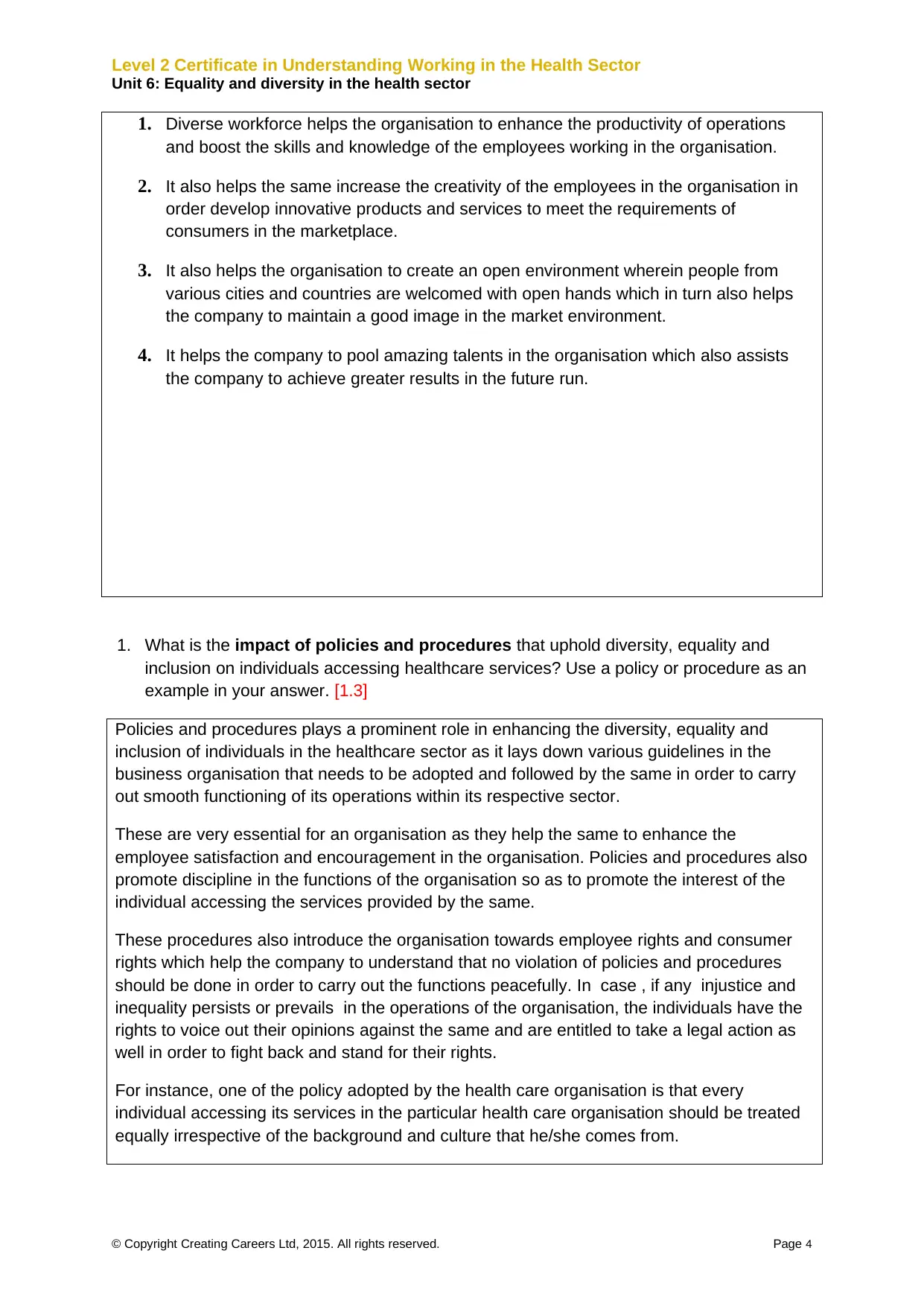
Level 2 Certificate in Understanding Working in the Health Sector
Unit 6: Equality and diversity in the health sector
1. Diverse workforce helps the organisation to enhance the productivity of operations
and boost the skills and knowledge of the employees working in the organisation.
2. It also helps the same increase the creativity of the employees in the organisation in
order develop innovative products and services to meet the requirements of
consumers in the marketplace.
3. It also helps the organisation to create an open environment wherein people from
various cities and countries are welcomed with open hands which in turn also helps
the company to maintain a good image in the market environment.
4. It helps the company to pool amazing talents in the organisation which also assists
the company to achieve greater results in the future run.
1. What is the impact of policies and procedures that uphold diversity, equality and
inclusion on individuals accessing healthcare services? Use a policy or procedure as an
example in your answer. [1.3]
Policies and procedures plays a prominent role in enhancing the diversity, equality and
inclusion of individuals in the healthcare sector as it lays down various guidelines in the
business organisation that needs to be adopted and followed by the same in order to carry
out smooth functioning of its operations within its respective sector.
These are very essential for an organisation as they help the same to enhance the
employee satisfaction and encouragement in the organisation. Policies and procedures also
promote discipline in the functions of the organisation so as to promote the interest of the
individual accessing the services provided by the same.
These procedures also introduce the organisation towards employee rights and consumer
rights which help the company to understand that no violation of policies and procedures
should be done in order to carry out the functions peacefully. In case , if any injustice and
inequality persists or prevails in the operations of the organisation, the individuals have the
rights to voice out their opinions against the same and are entitled to take a legal action as
well in order to fight back and stand for their rights.
For instance, one of the policy adopted by the health care organisation is that every
individual accessing its services in the particular health care organisation should be treated
equally irrespective of the background and culture that he/she comes from.
© Copyright Creating Careers Ltd, 2015. All rights reserved. Page 4
Unit 6: Equality and diversity in the health sector
1. Diverse workforce helps the organisation to enhance the productivity of operations
and boost the skills and knowledge of the employees working in the organisation.
2. It also helps the same increase the creativity of the employees in the organisation in
order develop innovative products and services to meet the requirements of
consumers in the marketplace.
3. It also helps the organisation to create an open environment wherein people from
various cities and countries are welcomed with open hands which in turn also helps
the company to maintain a good image in the market environment.
4. It helps the company to pool amazing talents in the organisation which also assists
the company to achieve greater results in the future run.
1. What is the impact of policies and procedures that uphold diversity, equality and
inclusion on individuals accessing healthcare services? Use a policy or procedure as an
example in your answer. [1.3]
Policies and procedures plays a prominent role in enhancing the diversity, equality and
inclusion of individuals in the healthcare sector as it lays down various guidelines in the
business organisation that needs to be adopted and followed by the same in order to carry
out smooth functioning of its operations within its respective sector.
These are very essential for an organisation as they help the same to enhance the
employee satisfaction and encouragement in the organisation. Policies and procedures also
promote discipline in the functions of the organisation so as to promote the interest of the
individual accessing the services provided by the same.
These procedures also introduce the organisation towards employee rights and consumer
rights which help the company to understand that no violation of policies and procedures
should be done in order to carry out the functions peacefully. In case , if any injustice and
inequality persists or prevails in the operations of the organisation, the individuals have the
rights to voice out their opinions against the same and are entitled to take a legal action as
well in order to fight back and stand for their rights.
For instance, one of the policy adopted by the health care organisation is that every
individual accessing its services in the particular health care organisation should be treated
equally irrespective of the background and culture that he/she comes from.
© Copyright Creating Careers Ltd, 2015. All rights reserved. Page 4
Paraphrase This Document
Need a fresh take? Get an instant paraphrase of this document with our AI Paraphraser
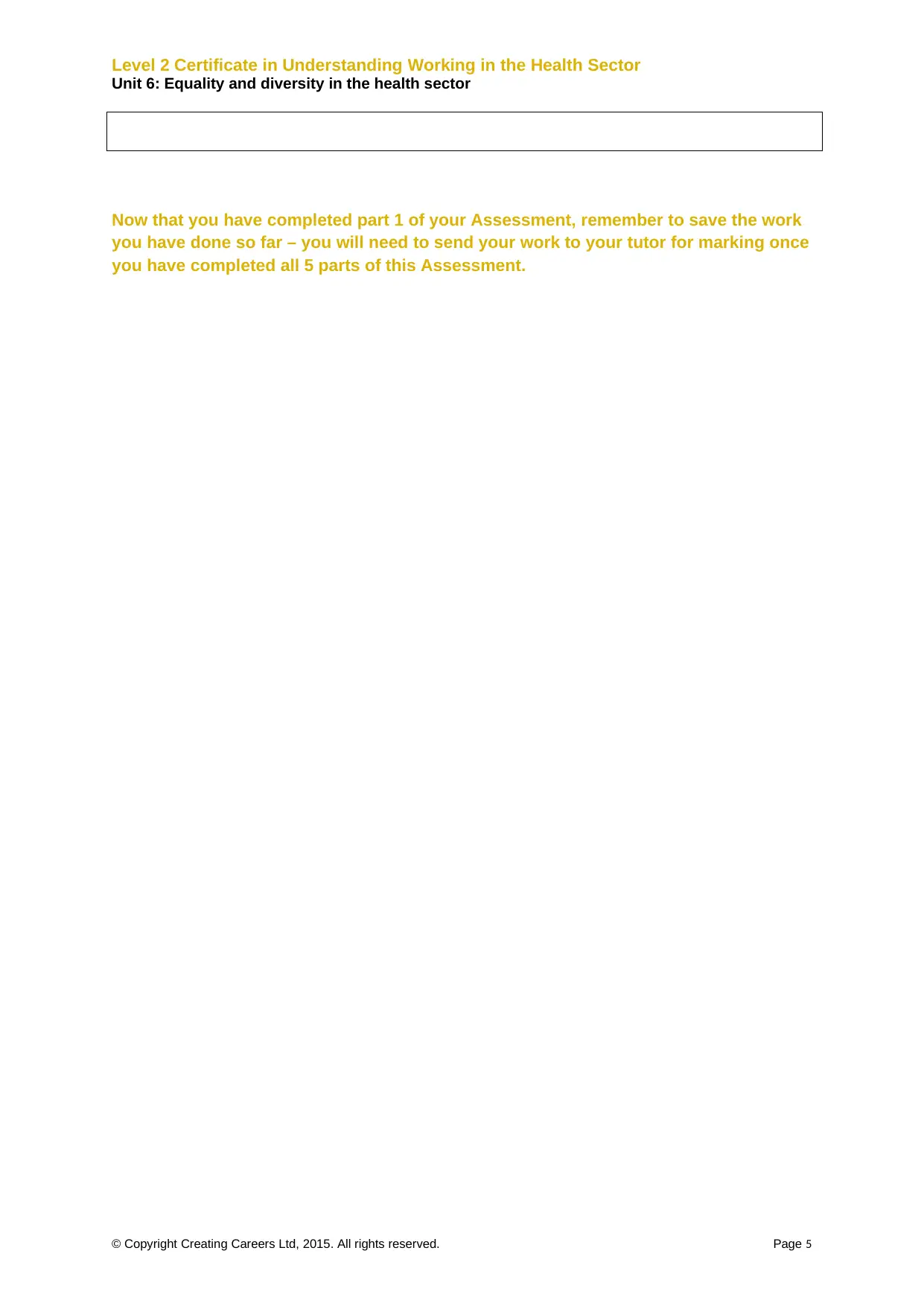
Level 2 Certificate in Understanding Working in the Health Sector
Unit 6: Equality and diversity in the health sector
Now that you have completed part 1 of your Assessment, remember to save the work
you have done so far – you will need to send your work to your tutor for marking once
you have completed all 5 parts of this Assessment.
© Copyright Creating Careers Ltd, 2015. All rights reserved. Page 5
Unit 6: Equality and diversity in the health sector
Now that you have completed part 1 of your Assessment, remember to save the work
you have done so far – you will need to send your work to your tutor for marking once
you have completed all 5 parts of this Assessment.
© Copyright Creating Careers Ltd, 2015. All rights reserved. Page 5
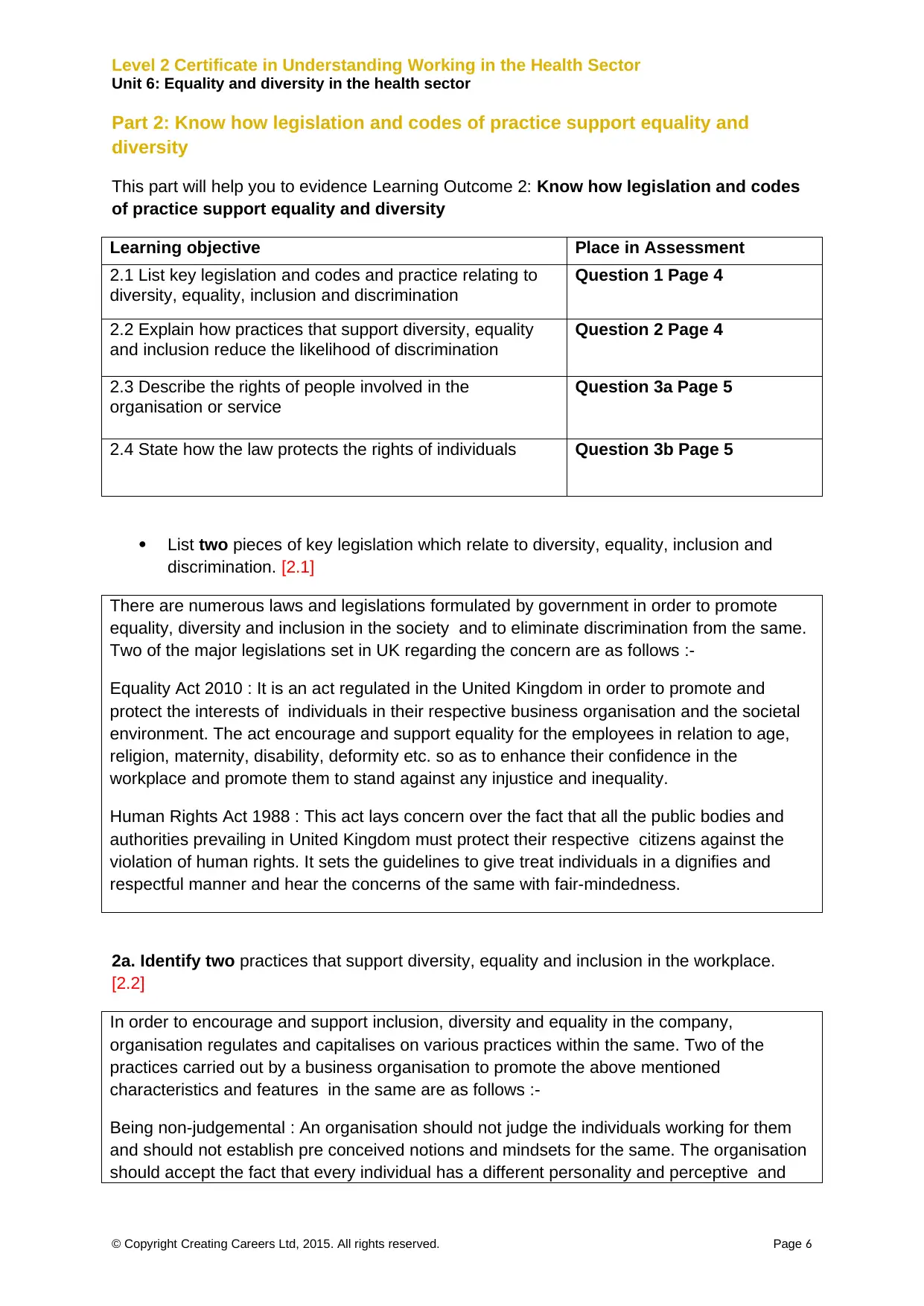
Level 2 Certificate in Understanding Working in the Health Sector
Unit 6: Equality and diversity in the health sector
Part 2: Know how legislation and codes of practice support equality and
diversity
This part will help you to evidence Learning Outcome 2: Know how legislation and codes
of practice support equality and diversity
Learning objective Place in Assessment
2.1 List key legislation and codes and practice relating to
diversity, equality, inclusion and discrimination
Question 1 Page 4
2.2 Explain how practices that support diversity, equality
and inclusion reduce the likelihood of discrimination
Question 2 Page 4
2.3 Describe the rights of people involved in the
organisation or service
Question 3a Page 5
2.4 State how the law protects the rights of individuals Question 3b Page 5
List two pieces of key legislation which relate to diversity, equality, inclusion and
discrimination. [2.1]
There are numerous laws and legislations formulated by government in order to promote
equality, diversity and inclusion in the society and to eliminate discrimination from the same.
Two of the major legislations set in UK regarding the concern are as follows :-
Equality Act 2010 : It is an act regulated in the United Kingdom in order to promote and
protect the interests of individuals in their respective business organisation and the societal
environment. The act encourage and support equality for the employees in relation to age,
religion, maternity, disability, deformity etc. so as to enhance their confidence in the
workplace and promote them to stand against any injustice and inequality.
Human Rights Act 1988 : This act lays concern over the fact that all the public bodies and
authorities prevailing in United Kingdom must protect their respective citizens against the
violation of human rights. It sets the guidelines to give treat individuals in a dignifies and
respectful manner and hear the concerns of the same with fair-mindedness.
2a. Identify two practices that support diversity, equality and inclusion in the workplace.
[2.2]
In order to encourage and support inclusion, diversity and equality in the company,
organisation regulates and capitalises on various practices within the same. Two of the
practices carried out by a business organisation to promote the above mentioned
characteristics and features in the same are as follows :-
Being non-judgemental : An organisation should not judge the individuals working for them
and should not establish pre conceived notions and mindsets for the same. The organisation
should accept the fact that every individual has a different personality and perceptive and
© Copyright Creating Careers Ltd, 2015. All rights reserved. Page 6
Unit 6: Equality and diversity in the health sector
Part 2: Know how legislation and codes of practice support equality and
diversity
This part will help you to evidence Learning Outcome 2: Know how legislation and codes
of practice support equality and diversity
Learning objective Place in Assessment
2.1 List key legislation and codes and practice relating to
diversity, equality, inclusion and discrimination
Question 1 Page 4
2.2 Explain how practices that support diversity, equality
and inclusion reduce the likelihood of discrimination
Question 2 Page 4
2.3 Describe the rights of people involved in the
organisation or service
Question 3a Page 5
2.4 State how the law protects the rights of individuals Question 3b Page 5
List two pieces of key legislation which relate to diversity, equality, inclusion and
discrimination. [2.1]
There are numerous laws and legislations formulated by government in order to promote
equality, diversity and inclusion in the society and to eliminate discrimination from the same.
Two of the major legislations set in UK regarding the concern are as follows :-
Equality Act 2010 : It is an act regulated in the United Kingdom in order to promote and
protect the interests of individuals in their respective business organisation and the societal
environment. The act encourage and support equality for the employees in relation to age,
religion, maternity, disability, deformity etc. so as to enhance their confidence in the
workplace and promote them to stand against any injustice and inequality.
Human Rights Act 1988 : This act lays concern over the fact that all the public bodies and
authorities prevailing in United Kingdom must protect their respective citizens against the
violation of human rights. It sets the guidelines to give treat individuals in a dignifies and
respectful manner and hear the concerns of the same with fair-mindedness.
2a. Identify two practices that support diversity, equality and inclusion in the workplace.
[2.2]
In order to encourage and support inclusion, diversity and equality in the company,
organisation regulates and capitalises on various practices within the same. Two of the
practices carried out by a business organisation to promote the above mentioned
characteristics and features in the same are as follows :-
Being non-judgemental : An organisation should not judge the individuals working for them
and should not establish pre conceived notions and mindsets for the same. The organisation
should accept the fact that every individual has a different personality and perceptive and
© Copyright Creating Careers Ltd, 2015. All rights reserved. Page 6
⊘ This is a preview!⊘
Do you want full access?
Subscribe today to unlock all pages.

Trusted by 1+ million students worldwide
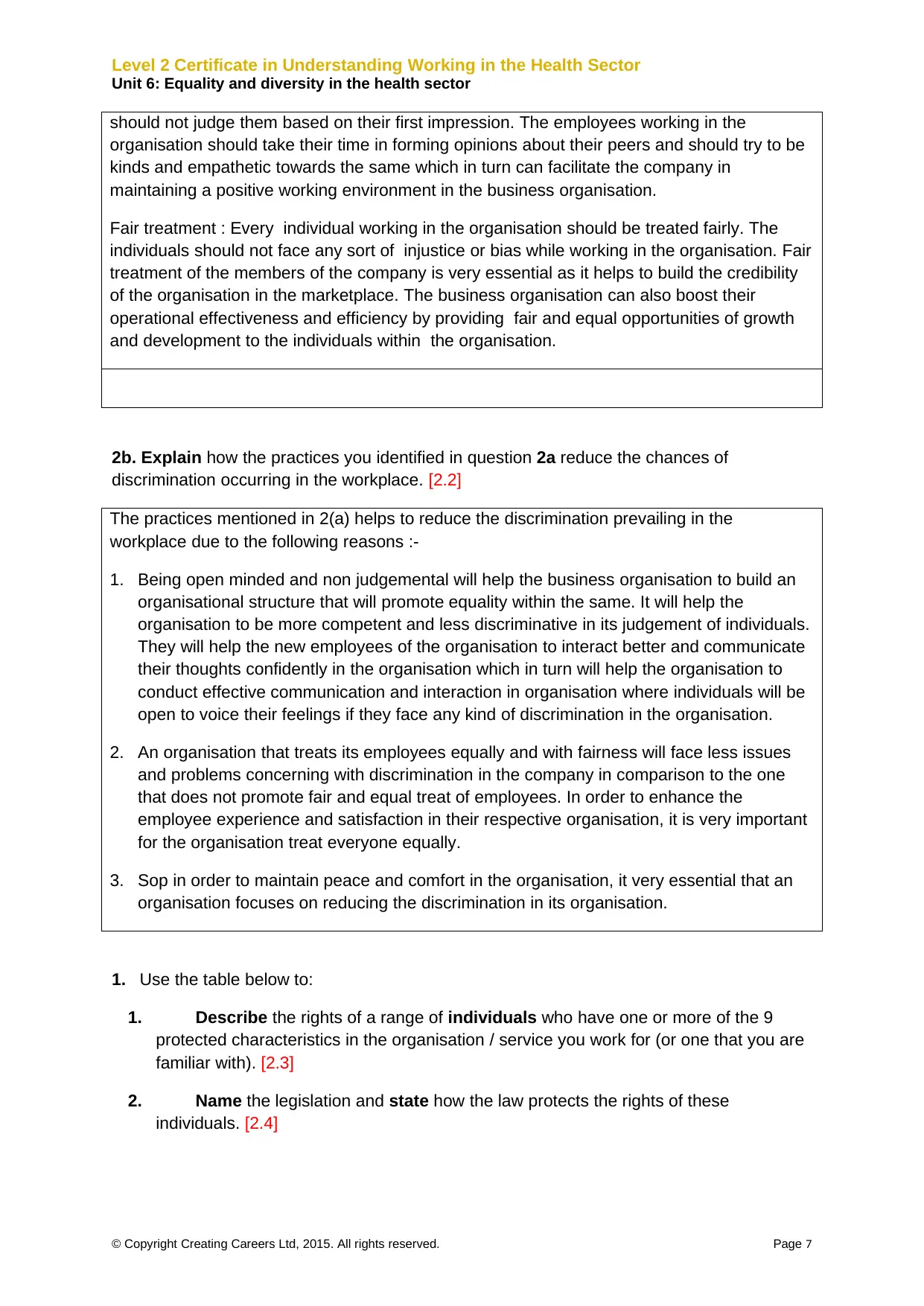
Level 2 Certificate in Understanding Working in the Health Sector
Unit 6: Equality and diversity in the health sector
should not judge them based on their first impression. The employees working in the
organisation should take their time in forming opinions about their peers and should try to be
kinds and empathetic towards the same which in turn can facilitate the company in
maintaining a positive working environment in the business organisation.
Fair treatment : Every individual working in the organisation should be treated fairly. The
individuals should not face any sort of injustice or bias while working in the organisation. Fair
treatment of the members of the company is very essential as it helps to build the credibility
of the organisation in the marketplace. The business organisation can also boost their
operational effectiveness and efficiency by providing fair and equal opportunities of growth
and development to the individuals within the organisation.
2b. Explain how the practices you identified in question 2a reduce the chances of
discrimination occurring in the workplace. [2.2]
The practices mentioned in 2(a) helps to reduce the discrimination prevailing in the
workplace due to the following reasons :-
1. Being open minded and non judgemental will help the business organisation to build an
organisational structure that will promote equality within the same. It will help the
organisation to be more competent and less discriminative in its judgement of individuals.
They will help the new employees of the organisation to interact better and communicate
their thoughts confidently in the organisation which in turn will help the organisation to
conduct effective communication and interaction in organisation where individuals will be
open to voice their feelings if they face any kind of discrimination in the organisation.
2. An organisation that treats its employees equally and with fairness will face less issues
and problems concerning with discrimination in the company in comparison to the one
that does not promote fair and equal treat of employees. In order to enhance the
employee experience and satisfaction in their respective organisation, it is very important
for the organisation treat everyone equally.
3. Sop in order to maintain peace and comfort in the organisation, it very essential that an
organisation focuses on reducing the discrimination in its organisation.
1. Use the table below to:
1. Describe the rights of a range of individuals who have one or more of the 9
protected characteristics in the organisation / service you work for (or one that you are
familiar with). [2.3]
2. Name the legislation and state how the law protects the rights of these
individuals. [2.4]
© Copyright Creating Careers Ltd, 2015. All rights reserved. Page 7
Unit 6: Equality and diversity in the health sector
should not judge them based on their first impression. The employees working in the
organisation should take their time in forming opinions about their peers and should try to be
kinds and empathetic towards the same which in turn can facilitate the company in
maintaining a positive working environment in the business organisation.
Fair treatment : Every individual working in the organisation should be treated fairly. The
individuals should not face any sort of injustice or bias while working in the organisation. Fair
treatment of the members of the company is very essential as it helps to build the credibility
of the organisation in the marketplace. The business organisation can also boost their
operational effectiveness and efficiency by providing fair and equal opportunities of growth
and development to the individuals within the organisation.
2b. Explain how the practices you identified in question 2a reduce the chances of
discrimination occurring in the workplace. [2.2]
The practices mentioned in 2(a) helps to reduce the discrimination prevailing in the
workplace due to the following reasons :-
1. Being open minded and non judgemental will help the business organisation to build an
organisational structure that will promote equality within the same. It will help the
organisation to be more competent and less discriminative in its judgement of individuals.
They will help the new employees of the organisation to interact better and communicate
their thoughts confidently in the organisation which in turn will help the organisation to
conduct effective communication and interaction in organisation where individuals will be
open to voice their feelings if they face any kind of discrimination in the organisation.
2. An organisation that treats its employees equally and with fairness will face less issues
and problems concerning with discrimination in the company in comparison to the one
that does not promote fair and equal treat of employees. In order to enhance the
employee experience and satisfaction in their respective organisation, it is very important
for the organisation treat everyone equally.
3. Sop in order to maintain peace and comfort in the organisation, it very essential that an
organisation focuses on reducing the discrimination in its organisation.
1. Use the table below to:
1. Describe the rights of a range of individuals who have one or more of the 9
protected characteristics in the organisation / service you work for (or one that you are
familiar with). [2.3]
2. Name the legislation and state how the law protects the rights of these
individuals. [2.4]
© Copyright Creating Careers Ltd, 2015. All rights reserved. Page 7
Paraphrase This Document
Need a fresh take? Get an instant paraphrase of this document with our AI Paraphraser
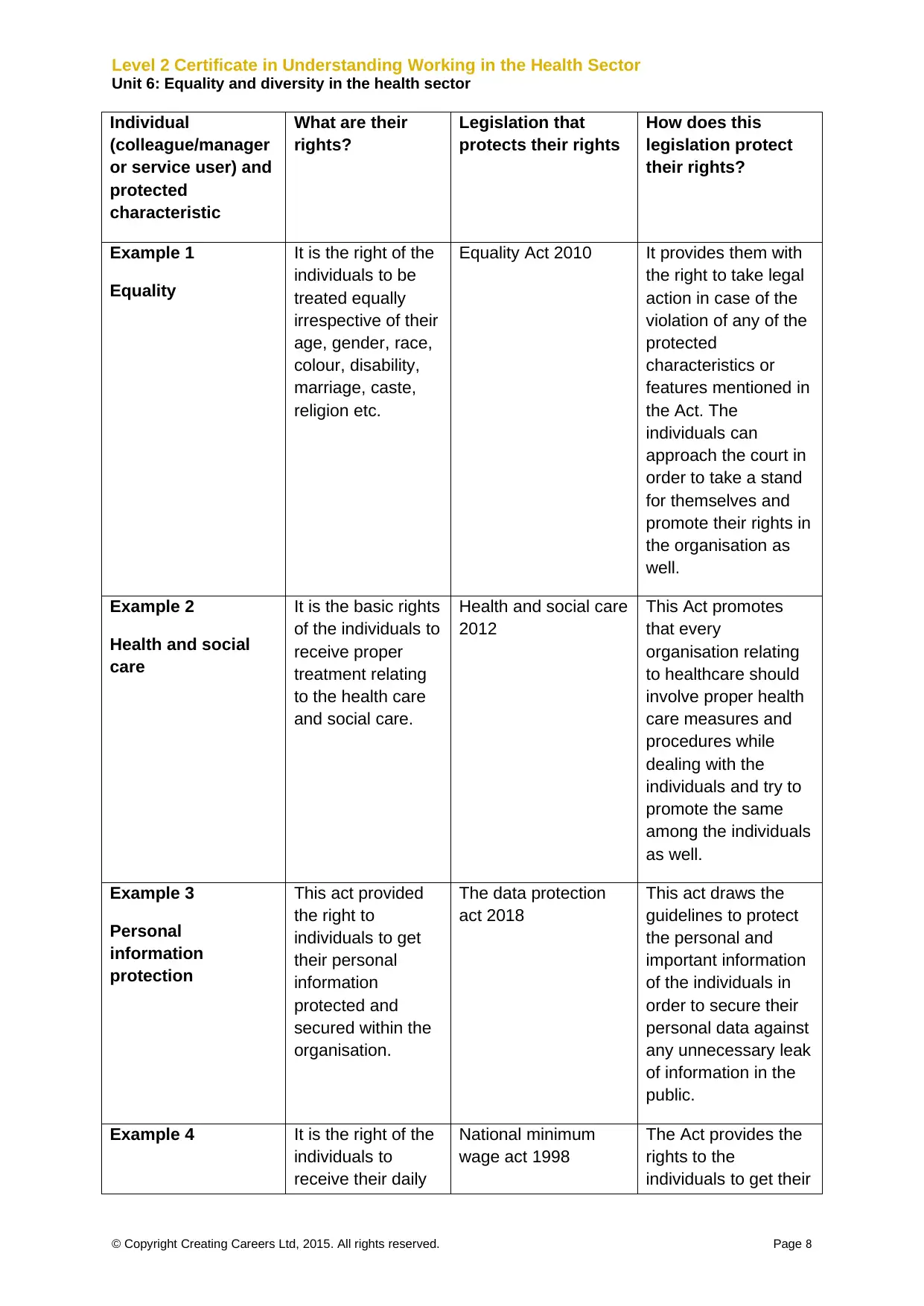
Level 2 Certificate in Understanding Working in the Health Sector
Unit 6: Equality and diversity in the health sector
Individual
(colleague/manager
or service user) and
protected
characteristic
What are their
rights?
Legislation that
protects their rights
How does this
legislation protect
their rights?
Example 1
Equality
It is the right of the
individuals to be
treated equally
irrespective of their
age, gender, race,
colour, disability,
marriage, caste,
religion etc.
Equality Act 2010 It provides them with
the right to take legal
action in case of the
violation of any of the
protected
characteristics or
features mentioned in
the Act. The
individuals can
approach the court in
order to take a stand
for themselves and
promote their rights in
the organisation as
well.
Example 2
Health and social
care
It is the basic rights
of the individuals to
receive proper
treatment relating
to the health care
and social care.
Health and social care
2012
This Act promotes
that every
organisation relating
to healthcare should
involve proper health
care measures and
procedures while
dealing with the
individuals and try to
promote the same
among the individuals
as well.
Example 3
Personal
information
protection
This act provided
the right to
individuals to get
their personal
information
protected and
secured within the
organisation.
The data protection
act 2018
This act draws the
guidelines to protect
the personal and
important information
of the individuals in
order to secure their
personal data against
any unnecessary leak
of information in the
public.
Example 4 It is the right of the
individuals to
receive their daily
National minimum
wage act 1998
The Act provides the
rights to the
individuals to get their
© Copyright Creating Careers Ltd, 2015. All rights reserved. Page 8
Unit 6: Equality and diversity in the health sector
Individual
(colleague/manager
or service user) and
protected
characteristic
What are their
rights?
Legislation that
protects their rights
How does this
legislation protect
their rights?
Example 1
Equality
It is the right of the
individuals to be
treated equally
irrespective of their
age, gender, race,
colour, disability,
marriage, caste,
religion etc.
Equality Act 2010 It provides them with
the right to take legal
action in case of the
violation of any of the
protected
characteristics or
features mentioned in
the Act. The
individuals can
approach the court in
order to take a stand
for themselves and
promote their rights in
the organisation as
well.
Example 2
Health and social
care
It is the basic rights
of the individuals to
receive proper
treatment relating
to the health care
and social care.
Health and social care
2012
This Act promotes
that every
organisation relating
to healthcare should
involve proper health
care measures and
procedures while
dealing with the
individuals and try to
promote the same
among the individuals
as well.
Example 3
Personal
information
protection
This act provided
the right to
individuals to get
their personal
information
protected and
secured within the
organisation.
The data protection
act 2018
This act draws the
guidelines to protect
the personal and
important information
of the individuals in
order to secure their
personal data against
any unnecessary leak
of information in the
public.
Example 4 It is the right of the
individuals to
receive their daily
National minimum
wage act 1998
The Act provides the
rights to the
individuals to get their
© Copyright Creating Careers Ltd, 2015. All rights reserved. Page 8
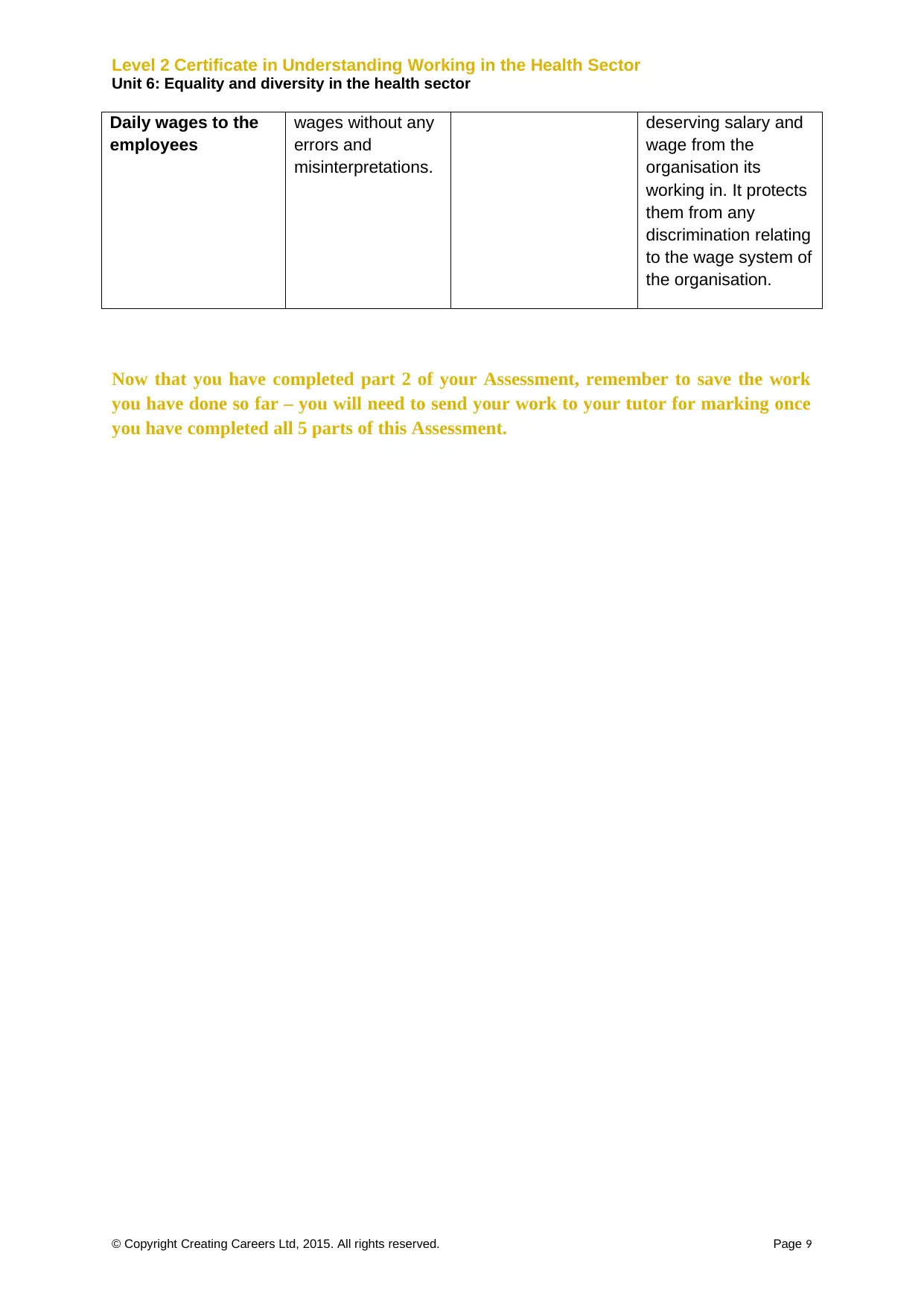
Level 2 Certificate in Understanding Working in the Health Sector
Unit 6: Equality and diversity in the health sector
Daily wages to the
employees
wages without any
errors and
misinterpretations.
deserving salary and
wage from the
organisation its
working in. It protects
them from any
discrimination relating
to the wage system of
the organisation.
Now that you have completed part 2 of your Assessment, remember to save the work
you have done so far – you will need to send your work to your tutor for marking once
you have completed all 5 parts of this Assessment.
© Copyright Creating Careers Ltd, 2015. All rights reserved. Page 9
Unit 6: Equality and diversity in the health sector
Daily wages to the
employees
wages without any
errors and
misinterpretations.
deserving salary and
wage from the
organisation its
working in. It protects
them from any
discrimination relating
to the wage system of
the organisation.
Now that you have completed part 2 of your Assessment, remember to save the work
you have done so far – you will need to send your work to your tutor for marking once
you have completed all 5 parts of this Assessment.
© Copyright Creating Careers Ltd, 2015. All rights reserved. Page 9
⊘ This is a preview!⊘
Do you want full access?
Subscribe today to unlock all pages.

Trusted by 1+ million students worldwide
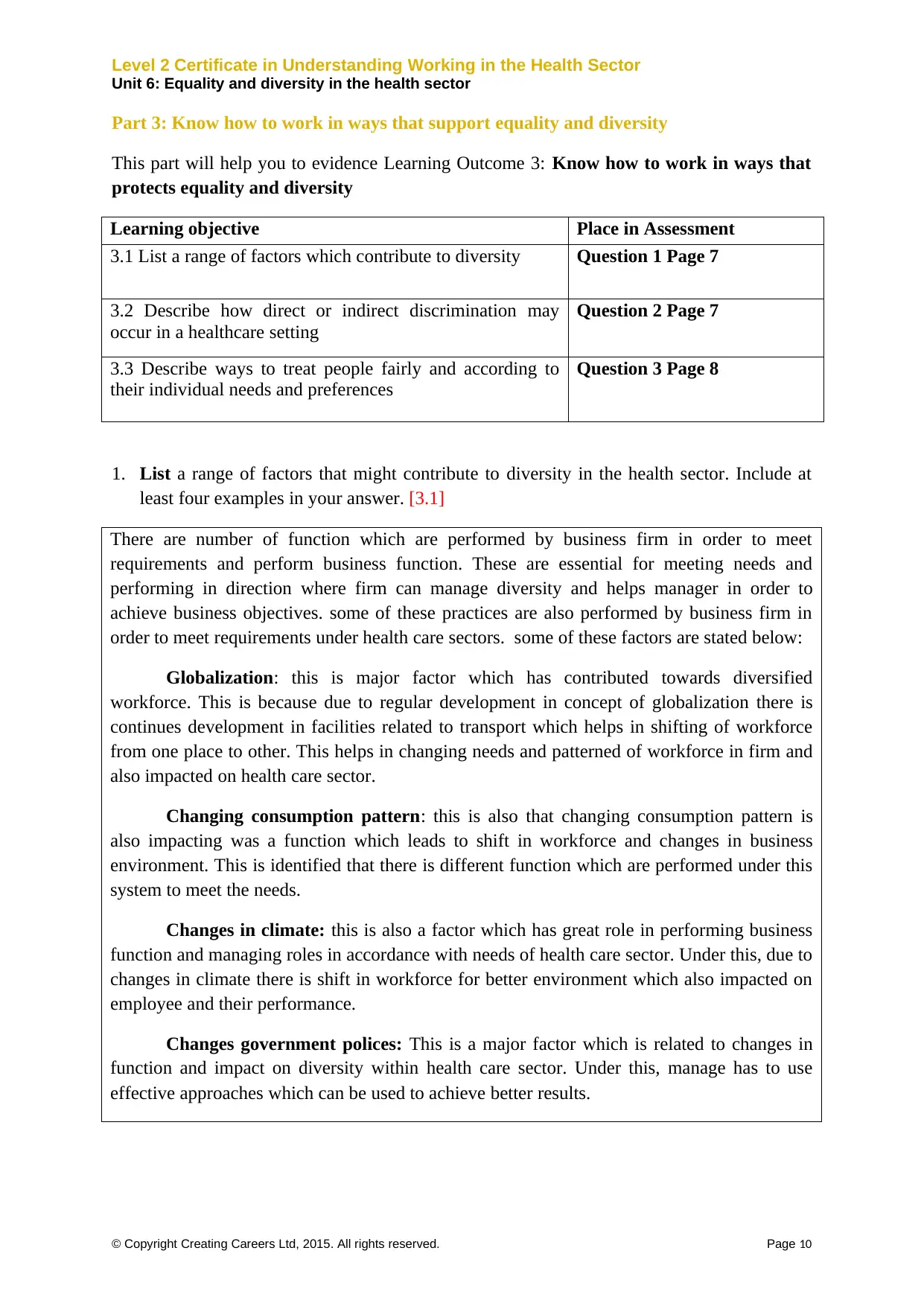
Level 2 Certificate in Understanding Working in the Health Sector
Unit 6: Equality and diversity in the health sector
Part 3: Know how to work in ways that support equality and diversity
This part will help you to evidence Learning Outcome 3: Know how to work in ways that
protects equality and diversity
Learning objective Place in Assessment
3.1 List a range of factors which contribute to diversity Question 1 Page 7
3.2 Describe how direct or indirect discrimination may
occur in a healthcare setting
Question 2 Page 7
3.3 Describe ways to treat people fairly and according to
their individual needs and preferences
Question 3 Page 8
1. List a range of factors that might contribute to diversity in the health sector. Include at
least four examples in your answer. [3.1]
There are number of function which are performed by business firm in order to meet
requirements and perform business function. These are essential for meeting needs and
performing in direction where firm can manage diversity and helps manager in order to
achieve business objectives. some of these practices are also performed by business firm in
order to meet requirements under health care sectors. some of these factors are stated below:
Globalization: this is major factor which has contributed towards diversified
workforce. This is because due to regular development in concept of globalization there is
continues development in facilities related to transport which helps in shifting of workforce
from one place to other. This helps in changing needs and patterned of workforce in firm and
also impacted on health care sector.
Changing consumption pattern: this is also that changing consumption pattern is
also impacting was a function which leads to shift in workforce and changes in business
environment. This is identified that there is different function which are performed under this
system to meet the needs.
Changes in climate: this is also a factor which has great role in performing business
function and managing roles in accordance with needs of health care sector. Under this, due to
changes in climate there is shift in workforce for better environment which also impacted on
employee and their performance.
Changes government polices: This is a major factor which is related to changes in
function and impact on diversity within health care sector. Under this, manage has to use
effective approaches which can be used to achieve better results.
© Copyright Creating Careers Ltd, 2015. All rights reserved. Page 10
Unit 6: Equality and diversity in the health sector
Part 3: Know how to work in ways that support equality and diversity
This part will help you to evidence Learning Outcome 3: Know how to work in ways that
protects equality and diversity
Learning objective Place in Assessment
3.1 List a range of factors which contribute to diversity Question 1 Page 7
3.2 Describe how direct or indirect discrimination may
occur in a healthcare setting
Question 2 Page 7
3.3 Describe ways to treat people fairly and according to
their individual needs and preferences
Question 3 Page 8
1. List a range of factors that might contribute to diversity in the health sector. Include at
least four examples in your answer. [3.1]
There are number of function which are performed by business firm in order to meet
requirements and perform business function. These are essential for meeting needs and
performing in direction where firm can manage diversity and helps manager in order to
achieve business objectives. some of these practices are also performed by business firm in
order to meet requirements under health care sectors. some of these factors are stated below:
Globalization: this is major factor which has contributed towards diversified
workforce. This is because due to regular development in concept of globalization there is
continues development in facilities related to transport which helps in shifting of workforce
from one place to other. This helps in changing needs and patterned of workforce in firm and
also impacted on health care sector.
Changing consumption pattern: this is also that changing consumption pattern is
also impacting was a function which leads to shift in workforce and changes in business
environment. This is identified that there is different function which are performed under this
system to meet the needs.
Changes in climate: this is also a factor which has great role in performing business
function and managing roles in accordance with needs of health care sector. Under this, due to
changes in climate there is shift in workforce for better environment which also impacted on
employee and their performance.
Changes government polices: This is a major factor which is related to changes in
function and impact on diversity within health care sector. Under this, manage has to use
effective approaches which can be used to achieve better results.
© Copyright Creating Careers Ltd, 2015. All rights reserved. Page 10
Paraphrase This Document
Need a fresh take? Get an instant paraphrase of this document with our AI Paraphraser
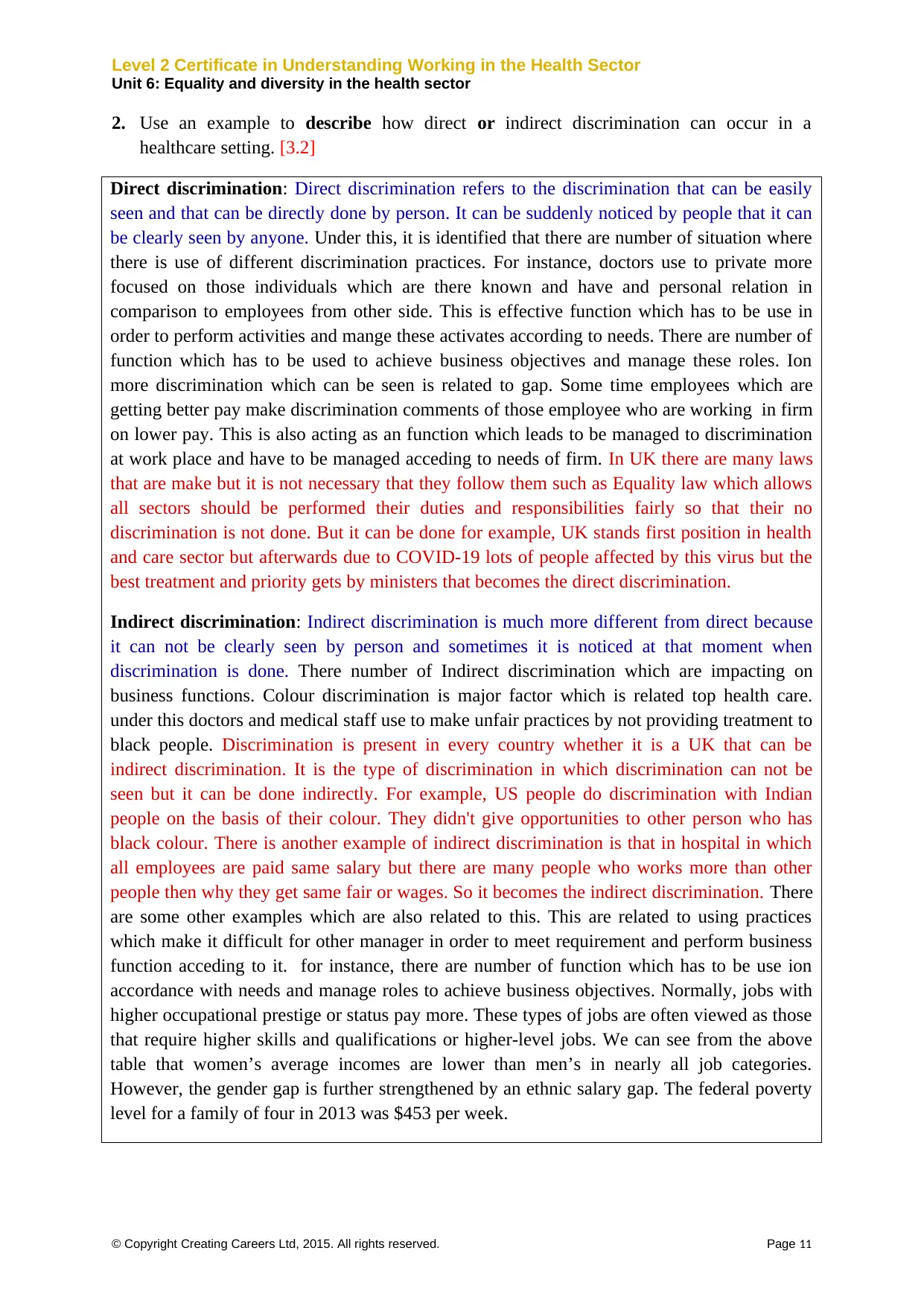
Level 2 Certificate in Understanding Working in the Health Sector
Unit 6: Equality and diversity in the health sector
2. Use an example to describe how direct or indirect discrimination can occur in a
healthcare setting. [3.2]
Direct discrimination: Direct discrimination refers to the discrimination that can be easily
seen and that can be directly done by person. It can be suddenly noticed by people that it can
be clearly seen by anyone. Under this, it is identified that there are number of situation where
there is use of different discrimination practices. For instance, doctors use to private more
focused on those individuals which are there known and have and personal relation in
comparison to employees from other side. This is effective function which has to be use in
order to perform activities and mange these activates according to needs. There are number of
function which has to be used to achieve business objectives and manage these roles. Ion
more discrimination which can be seen is related to gap. Some time employees which are
getting better pay make discrimination comments of those employee who are working in firm
on lower pay. This is also acting as an function which leads to be managed to discrimination
at work place and have to be managed acceding to needs of firm. In UK there are many laws
that are make but it is not necessary that they follow them such as Equality law which allows
all sectors should be performed their duties and responsibilities fairly so that their no
discrimination is not done. But it can be done for example, UK stands first position in health
and care sector but afterwards due to COVID-19 lots of people affected by this virus but the
best treatment and priority gets by ministers that becomes the direct discrimination.
Indirect discrimination: Indirect discrimination is much more different from direct because
it can not be clearly seen by person and sometimes it is noticed at that moment when
discrimination is done. There number of Indirect discrimination which are impacting on
business functions. Colour discrimination is major factor which is related top health care.
under this doctors and medical staff use to make unfair practices by not providing treatment to
black people. Discrimination is present in every country whether it is a UK that can be
indirect discrimination. It is the type of discrimination in which discrimination can not be
seen but it can be done indirectly. For example, US people do discrimination with Indian
people on the basis of their colour. They didn't give opportunities to other person who has
black colour. There is another example of indirect discrimination is that in hospital in which
all employees are paid same salary but there are many people who works more than other
people then why they get same fair or wages. So it becomes the indirect discrimination. There
are some other examples which are also related to this. This are related to using practices
which make it difficult for other manager in order to meet requirement and perform business
function acceding to it. for instance, there are number of function which has to be use ion
accordance with needs and manage roles to achieve business objectives. Normally, jobs with
higher occupational prestige or status pay more. These types of jobs are often viewed as those
that require higher skills and qualifications or higher-level jobs. We can see from the above
table that women’s average incomes are lower than men’s in nearly all job categories.
However, the gender gap is further strengthened by an ethnic salary gap. The federal poverty
level for a family of four in 2013 was $453 per week.
© Copyright Creating Careers Ltd, 2015. All rights reserved. Page 11
Unit 6: Equality and diversity in the health sector
2. Use an example to describe how direct or indirect discrimination can occur in a
healthcare setting. [3.2]
Direct discrimination: Direct discrimination refers to the discrimination that can be easily
seen and that can be directly done by person. It can be suddenly noticed by people that it can
be clearly seen by anyone. Under this, it is identified that there are number of situation where
there is use of different discrimination practices. For instance, doctors use to private more
focused on those individuals which are there known and have and personal relation in
comparison to employees from other side. This is effective function which has to be use in
order to perform activities and mange these activates according to needs. There are number of
function which has to be used to achieve business objectives and manage these roles. Ion
more discrimination which can be seen is related to gap. Some time employees which are
getting better pay make discrimination comments of those employee who are working in firm
on lower pay. This is also acting as an function which leads to be managed to discrimination
at work place and have to be managed acceding to needs of firm. In UK there are many laws
that are make but it is not necessary that they follow them such as Equality law which allows
all sectors should be performed their duties and responsibilities fairly so that their no
discrimination is not done. But it can be done for example, UK stands first position in health
and care sector but afterwards due to COVID-19 lots of people affected by this virus but the
best treatment and priority gets by ministers that becomes the direct discrimination.
Indirect discrimination: Indirect discrimination is much more different from direct because
it can not be clearly seen by person and sometimes it is noticed at that moment when
discrimination is done. There number of Indirect discrimination which are impacting on
business functions. Colour discrimination is major factor which is related top health care.
under this doctors and medical staff use to make unfair practices by not providing treatment to
black people. Discrimination is present in every country whether it is a UK that can be
indirect discrimination. It is the type of discrimination in which discrimination can not be
seen but it can be done indirectly. For example, US people do discrimination with Indian
people on the basis of their colour. They didn't give opportunities to other person who has
black colour. There is another example of indirect discrimination is that in hospital in which
all employees are paid same salary but there are many people who works more than other
people then why they get same fair or wages. So it becomes the indirect discrimination. There
are some other examples which are also related to this. This are related to using practices
which make it difficult for other manager in order to meet requirement and perform business
function acceding to it. for instance, there are number of function which has to be use ion
accordance with needs and manage roles to achieve business objectives. Normally, jobs with
higher occupational prestige or status pay more. These types of jobs are often viewed as those
that require higher skills and qualifications or higher-level jobs. We can see from the above
table that women’s average incomes are lower than men’s in nearly all job categories.
However, the gender gap is further strengthened by an ethnic salary gap. The federal poverty
level for a family of four in 2013 was $453 per week.
© Copyright Creating Careers Ltd, 2015. All rights reserved. Page 11
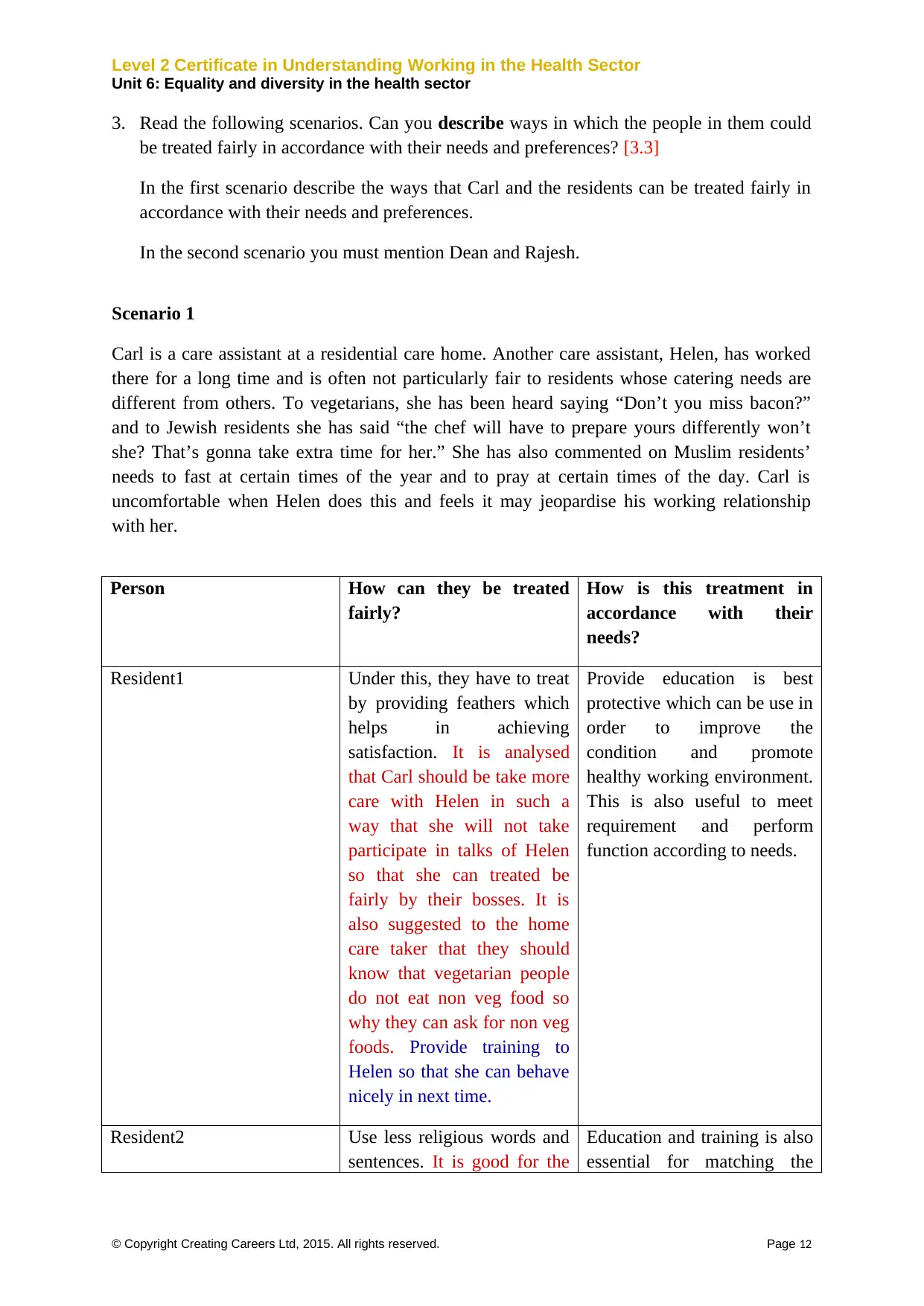
Level 2 Certificate in Understanding Working in the Health Sector
Unit 6: Equality and diversity in the health sector
3. Read the following scenarios. Can you describe ways in which the people in them could
be treated fairly in accordance with their needs and preferences? [3.3]
In the first scenario describe the ways that Carl and the residents can be treated fairly in
accordance with their needs and preferences.
In the second scenario you must mention Dean and Rajesh.
Scenario 1
Carl is a care assistant at a residential care home. Another care assistant, Helen, has worked
there for a long time and is often not particularly fair to residents whose catering needs are
different from others. To vegetarians, she has been heard saying “Don’t you miss bacon?”
and to Jewish residents she has said “the chef will have to prepare yours differently won’t
she? That’s gonna take extra time for her.” She has also commented on Muslim residents’
needs to fast at certain times of the year and to pray at certain times of the day. Carl is
uncomfortable when Helen does this and feels it may jeopardise his working relationship
with her.
Person How can they be treated
fairly?
How is this treatment in
accordance with their
needs?
Resident1 Under this, they have to treat
by providing feathers which
helps in achieving
satisfaction. It is analysed
that Carl should be take more
care with Helen in such a
way that she will not take
participate in talks of Helen
so that she can treated be
fairly by their bosses. It is
also suggested to the home
care taker that they should
know that vegetarian people
do not eat non veg food so
why they can ask for non veg
foods. Provide training to
Helen so that she can behave
nicely in next time.
Provide education is best
protective which can be use in
order to improve the
condition and promote
healthy working environment.
This is also useful to meet
requirement and perform
function according to needs.
Resident2 Use less religious words and
sentences. It is good for the
Education and training is also
essential for matching the
© Copyright Creating Careers Ltd, 2015. All rights reserved. Page 12
Unit 6: Equality and diversity in the health sector
3. Read the following scenarios. Can you describe ways in which the people in them could
be treated fairly in accordance with their needs and preferences? [3.3]
In the first scenario describe the ways that Carl and the residents can be treated fairly in
accordance with their needs and preferences.
In the second scenario you must mention Dean and Rajesh.
Scenario 1
Carl is a care assistant at a residential care home. Another care assistant, Helen, has worked
there for a long time and is often not particularly fair to residents whose catering needs are
different from others. To vegetarians, she has been heard saying “Don’t you miss bacon?”
and to Jewish residents she has said “the chef will have to prepare yours differently won’t
she? That’s gonna take extra time for her.” She has also commented on Muslim residents’
needs to fast at certain times of the year and to pray at certain times of the day. Carl is
uncomfortable when Helen does this and feels it may jeopardise his working relationship
with her.
Person How can they be treated
fairly?
How is this treatment in
accordance with their
needs?
Resident1 Under this, they have to treat
by providing feathers which
helps in achieving
satisfaction. It is analysed
that Carl should be take more
care with Helen in such a
way that she will not take
participate in talks of Helen
so that she can treated be
fairly by their bosses. It is
also suggested to the home
care taker that they should
know that vegetarian people
do not eat non veg food so
why they can ask for non veg
foods. Provide training to
Helen so that she can behave
nicely in next time.
Provide education is best
protective which can be use in
order to improve the
condition and promote
healthy working environment.
This is also useful to meet
requirement and perform
function according to needs.
Resident2 Use less religious words and
sentences. It is good for the
Education and training is also
essential for matching the
© Copyright Creating Careers Ltd, 2015. All rights reserved. Page 12
⊘ This is a preview!⊘
Do you want full access?
Subscribe today to unlock all pages.

Trusted by 1+ million students worldwide
1 out of 20
Related Documents
Your All-in-One AI-Powered Toolkit for Academic Success.
+13062052269
info@desklib.com
Available 24*7 on WhatsApp / Email
![[object Object]](/_next/static/media/star-bottom.7253800d.svg)
Unlock your academic potential
Copyright © 2020–2025 A2Z Services. All Rights Reserved. Developed and managed by ZUCOL.





